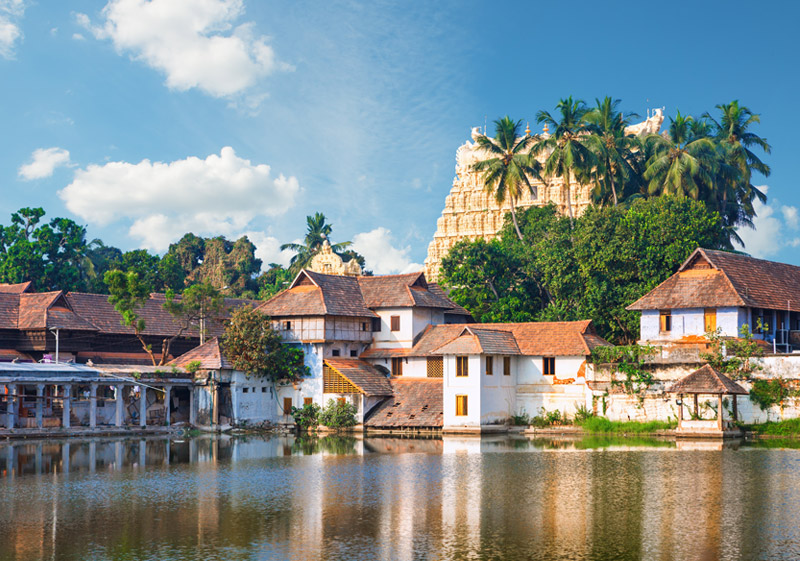6 mins 1st January 2020
In 2011, the Padmanabhaswamy temple in Thiruvananthapuram made international headlines when a mind-boggling treasure valued at USD 22 billion tumbled out of its underground vaults. Up until the vaults revealed their spectacular hoard, the temple
was considered the private sanctuary of the Travancore royal family.
How did the Travancore royals get this wealthy and why did they stash away their treasure in these secret chambers?

Our story begins in a magnificent wooden palace in Padmanabhapuram, ‘the city of Padmanabha’, 60 km south of Thiruvananthapuram in Kerala. We are in the 1720s and Padmanabhapuram is the seat of power of the Travancore kings. Back then,
Thiruvananthapuram was a nondescript village and the Padmanabhaswamy temple was no more than a small wooden shrine dedicated to Vishnu.
This was a time when one of Travancore’s greatest kings, Martanda Varma (1705-1758), was born into a family that ruled the minor chiefdom of Thiruvithaamkoor, later Anglicized as ‘Travancore’. He belonged to a minor branch of
the Venad royal family, one of the many small chiefdoms ruled by the powerful Nair clans in the region.
Martanda Varma was destined for great things and, in the 1730s, he defeated the other small chieftains and concentrated all power in his own hands. A true empire builder, he expanded his kingdom till it extended from Kanyakumari in the south to
Kozhikode in the north. The territories he conquered comprised the modern state of Travancore.
The key to his victories was a strong and disciplined army often described as a ‘war machine’, and with this force, Martanda Varma defeated the Dutch in the Battle of Colachel in 1741. His many victories and the international trade
revenue he earned from the ports he brought under his control earned him untold wealth.
Some of this wealth was used to fortify the Padmanabhapuram palace, spread across 86 acres, with granite walls. The royal abode had originally been built in 1601 CE by Ravipillai Ravivarma Kulashekhara Perumal, who ruled the Kingdom of Venad between
1592 and 1609 CE.
[Also Read: Fort Aguada: the Pride of Portuguese heritage ]
Martanda Varma took another monumental decision and made sure that Padmanabhapuram was the centre of the lucrative pepper trade that had made Kerala so famous the world over. This further swelled his coffers, considering that pepper and other
Indian spices were in demand across the oceans. Power and wealth together made Padmanabhapuram one of the most powerful capitals in the region, at the time.
At the pinnacle of his power in 1750, Martanda Varma took another far-reaching decision. He made a Thrippati Danam – he pledged his kingdom to his family deity, Lord Padmanabhaswamy. He also declared that from then on, he and his heirs would
rule the kingdom as ‘Padmanabhadasas’ or servants of Lord Padmanabha. It’s something the family follows even today.
Martanda Varma’s seemingly boundless wealth is the key to the treasure uncovered in the Padmanabhaswamy temple’s vaults; it was donated by the Travancore king during his Thrippati Danam.
Padmanabhapuram began to lose its importance when Martanda Varma’s successor, Karthika Thirunnal Rama Varma or Dharma Raja (1758- 1798), shifted the capital of the Travancore kingdom to Thiruvananthapuram, as it was closer to the family
deity and also a more strategic location. The old city began to fade and the palace emptied out.
In 1938, the palace was declared a monument of historical importance. In one of those political anomalies, during the reorganisation of states on linguistic lines in 1956, Padmanabhapuram was given to neighbouring Tamil Nadu. However, income from
the palace museum as well as the cost of maintaining the monument is shared in equal parts between the governments of Kerala and Tamil Nadu.
The Travancore state continued to grow in importance and its coffers too expanded greatly. In time, it was the only kingdom left standing in the region, apart from the Kingdom of Cochin, following repeated attacks from Tipu Sultan in 1789-90 CE.
The British helped Travancore, and thanks to their support, the Travancore royal family acquired more prominence than the Zamorins of Calicut as well as the royal family of Cochin, both of which eventually faded into obscurity.
Padmanabhapuram palace is a sliver of Kerala trapped in Tamil Nadu and a popular tourist attraction. Walk its halls, rooms and courtyards and revel in its carved teak ceilings, mahogany furniture and murals. And while you turn a page in history,
remember an ambitious king called Martanda Varma and his royal hoard!
Kerala is a popular holiday destination, especially during the November to January months, thanks to the pleasant weather. If you are planning a trip to Kerala, include Thiruvananthapuam in your itinerary. Apart from the Padmanabhapuram palace
and Padmanabhawamy temple, there are many other destinations that make for exciting day-long excursions from Thiruvananthapuram, such as Kovalam Beach, Poovar Island, Neyyar Dam and the Ponmudi hills. When planning your trip, use your Axis
Bank credit cards to enjoy deals and offers on airline tickets and hotel stays. If you find yourself falling short of funds, consider a Holiday Loan from Axis Bank that offers a two-month moratorium facility. With flexible repayment options, travel is always within your reach.
Disclaimer : This article has been authored by Live History India Digital, a Mumbai based Digital Content Company. Axis Bank doesn’t influence any views of the author in any way. Axis Bank & Live History India Digital shall not be responsible for any direct / indirect loss or liability incurred by the reader for taking any financial decisions based on the contents and information. Please consult your financial advisor before making any financial decision.


















